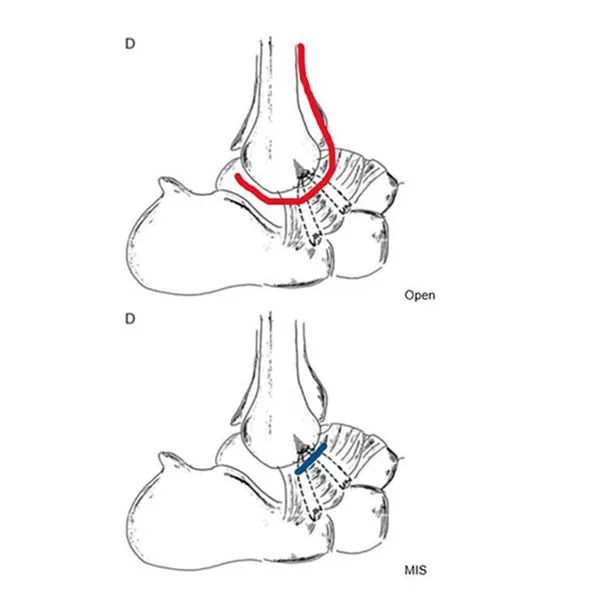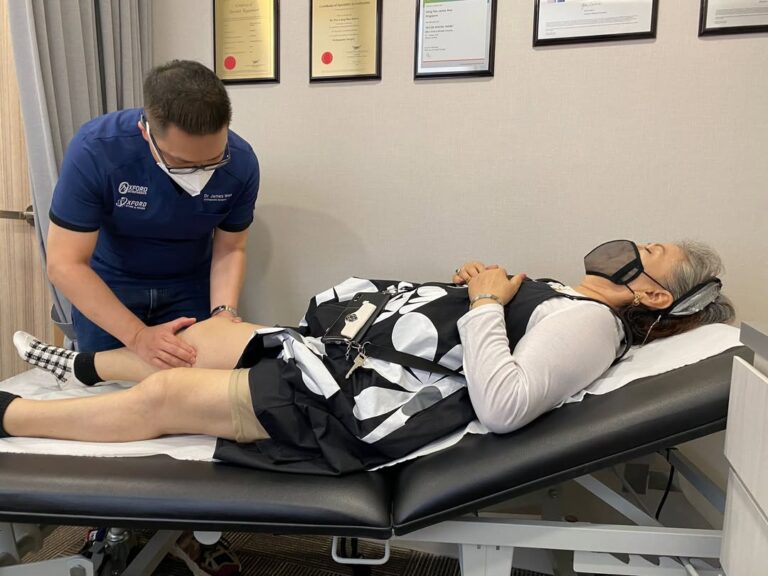
Coming to 20 Years of Experience


Ankle Ligament Reconstruction is the surgical treatment of ankle injuries or damaged ankle ligaments to restore stability and function.
Co-developed by Orthopaedic Surgeon, Dr James Wee, the Minimally Invasive Surgical (MIS) “Lasso” technique has the distinction of achieving successful outcomes of percutaneous ankle ligament reconstruction with just a single 1cm incision. This is much smaller than 6 – 8cm needed for an open reconstruction.
The ankle ligaments are repaired using a single suture anchor, and the repair is reinforced by recruiting an adjacent band of tissue for additional strength.
Benefits:

If you’re living with an ongoing ankle sprain, stiffness, or instability, ignoring it or relying on ankle guards will not reverse the damage.
Cartilage and ligament injuries don’t heal on their own.
Delaying proper treatment can lead to long-term deterioration, chronic pain, and eventually, more invasive surgery.

The Minimally Invasive Surgical (MIS) “Lasso” technique successfully reconstructs ankle ligaments with a single 1cm incision, 6-8cm smaller than open reconstruction. Preserves more of your natural ankle and reduces recovery time.

Specialises in keyhole arthroscopy and minimally invasive joint preservation, always prioritising targeted treatment over aggressive intervention.

One of the few surgeons in Singapore trained in both Hip & Knee and Foot & Ankle Surgery, offering comprehensive care for lower limb conditions, with over 20 years of surgical experience.

Minimally Invasive Surgery (MIS) offers significant benefits compared to open surgery. Unlike traditional open surgeries that require large incisions and extensive tissue disruption, Minimally Invasive Surgery (MIS) utilises specialised tools and techniques to access the knee through small incisions.
Whether it’s a mild ankle sprain or something a little more serious, we treat each ankle sprain with the utmost care by personalising your treatment to your lifestyle needs. This includes:
Initial treatment for ankle sprains include the RICE method and prescription of certain medications to help reduce pain and inflammation of the ankle.
Our orthopaedic specialist may also recommend physiotherapy or the use of a functional brace to control and prevent excessive turning of the ankle.
Surgery is recommended if you develop ankle instability and recurrent sprains that persist after rehabilitative physiotherapy.
Our orthopaedic specialist may recommend minimally invasive surgery (MIS) to facilitate rapid recovery and early return to high-level sports and dance activities.



Dr James Wee is an Senior Consultant Orthopaedic Surgeon with dual-subspecialties in both Hip & Knee and Foot & Ankle Surgery. He is a complete lower limb surgeon, coming to 20 years of clinical experience.
He was trained in the UK and is an expert in complex minimally invasive procedures as well as surgical intervention. He also co-published the “Lasso” Technique for ankle ligament reconstruction, a minimally invasive surgical (MIS) technique using only a single 1cm incision.
Aside from clinical practice, Dr Wee was appointed Adjunct Assistant Professor in Lee Kong Chian School of Medicine, a Senior Lecturer in Yong Loo Lin School of Medicine, and has authored multiple international peer-reviewed scientific journal articles.
Our clinic participates in:
Our staff will guide you through claims and billing to obtain a Letter of Guarantee (LOG) and pre-authorisation certificate, so you can focus on your recovery.
Patients are encouraged to contact our clinic for a detailed list of accepted insurance plans.































Ankle Sprains that are left untreated can lead to worsening damage and reduced mobility.
If you are unsure about your treatment options, book a consultation to get expert advice tailored to your condition.
Most ankle sprains heal with rest, physiotherapy, and bracing. However, if you continue to experience recurrent sprains, instability, or pain after rehab, imaging may reveal ligament tears or cartilage damage. In such cases, surgery, especially minimally invasive (MIS) options like the “Lasso” technique, may be recommended to restore stability and prevent long-term joint deterioration.
Grade 1 (Mild Sprain)
Slight stretch and microscopic tear of the ligament fibres with mild tenderness, bruising, and swelling around the ankle. Typically no pain with weightbearing and no instability upon examination.
Grade 2 (Moderate Sprain)
Partial tear of the ligament with moderate tenderness, bruising, and swelling around the ankle. Mild pain with weightbearing and slight instability upon examination.
Grade 3 (Severe Sprain)
Complete tear of the ligament with significant tenderness, bruising, and swelling around the ankle. Severe pain with weightbearing and substantial instability upon examination.
Delaying treatment especially for moderate to severe sprains can lead to: